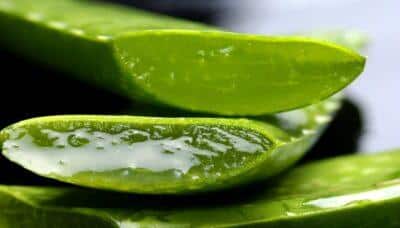Native to Eastern and Southern Africa, the prickly aloe vera plant has adapted to many climates throughout the world and has been used for centuries for herbal medicine. The perennial succulent is easy to grow and because of its many benefits and uses, it should find a place in your home.
Aloe gel is the clear, jelly-like substance found when you break open the fleshy aloe plant leaf. While there are many different species of the aloe plant, “aloe barbadensis miller” is the most widely used variety. If you are purchasing aloe vera gel, look for 100 percent pure aloe that is free of fragrance or dyes for the best benefits.
The Hidden Secrets Of Making Herbal Medicines…Right At Your Fingertips!
Of course, aloe vera gel is soothing when applied to the skin after a minor burn or sunburn. Try it in its natural gel-like state or in ice-cube format. To freeze, simply squeeze some gel into a clean ice cube tray. Freeze and then pop out cubes as needed to apply to burns, insect bites and skin rashes. But there are other uses, too. Here are eight:
- Shaving gel. Aloe is a great alternative to commercial shaving creams. The gel is anti-inflammatory, anti-bacterial and because of its high water content, it is very moisturizing.
- Hair conditioner. Aloe is a main ingredient in many hair conditioners and de-frizzing hair preparations. Its gel-like consistency makes it easy to apply, and its slightly acidic pH helps to seal the cuticle of the hair, helping to make it more manageable. Apply a small amount to your damp hair, work well through your hair and then rinse well. You can also use aloe vera gel to tame unruly eyebrows. Dip a mascara wand or a cotton swab in aloe vera gel and swipe across your brow to keep hairs tidy and in place.
- Acne treatment. Aloe vera contains vitamins A, C and E, and enzymes that can help reduce the inflammation and irritation of acne. Aloe vera also helps to heal acne scars by preventing excess oil build-up and by keeping the skin hydrated.
- Face wash. Here’s an all-natural, effective face wash: Mix one tablespoon of aloe vera gel with one teaspoon of almond milk and one teaspoon of lemon juice. Apply to your face and let it sit for a few minutes before rinsing well with warm water. Since the aloe vera gives the wash an anti-bacterial boost, this cleanser is a good choice for acne-prone sensitive skin.
- Makeup remover. Forget the pricey commercial solutions. Simply squeeze a little aloe vera gel onto a cotton ball and gently wipe away eye makeup.
- Exfoliator. Use aloe vera as the base for a great homemade skin scrub. It both softens and strengthens the skin. Mix a half cup of aloe vera with enough baking soda to create a gritty texture. Then rub the mixture on elbows, heels or other dry areas of the skin that need softening. Rinse well.
- Breath freshener. Mix one-fourth cup of pure aloe vera gel in a half cup of water. Sip and swish the solution around your mouth before rinsing well. How does it work? Aloe vera contains Beta sitosterol, an anti-inflammatory compound that eases acid indigestion, a common cause of bad breath.
- Hand sanitizer. Skip all the drying chemicals in commercial hand sanitizers and try this instead. Mix together six ounces of water, two tablespoons of aloe vera gel, 10 drops of eucalyptus oil and 20 drops of either lemon, wild orange or grapefruit essential oil. Pour into a small spray bottle or into a clean and dry liquid soap bottle. Rub into your hands and repeat as needed.
Called the “Medicine Plant” and the “Burn Plant,” aloe vera is easy to grow and care for as an indoor plant. Like cacti, succulents do not require much water. If its leaves turn brown and begin to sag, it is usually because you are over-watering the plant. Water only when the loose soil is completely dry. Keep your aloe vera plant near a sunny window but out of direct sunlight.
New All-Natural Capsule Protects You From Dangerous Toxins And Pollutants!
If your aloe vera plant’s roots are winding around its pot, you will know it is time to replant it in a larger pot. Before you do, take a look for the little root offshoots, sometimes called “pups” or “offsets.” You can gently cut these new growths off and plant them to start new plants.
Now, here’s how to find the “miracle” gel inside the aloe vera leaves. Although you can snap off leaves with your hands, it is best to use a sharp knife to avoid any tearing or otherwise damaging the plant. Use the knife to cut a leaf at its base where it meets the soil line.
Simply squeeze the gel out of the inside of the leaf and it is ready to use. If you do not need all the gel inside, you can wrap the leaf in foil and place it in the refrigerator where it will keep fresh for four to five days. The leaf will callous over at the cut, but if you gently scrape the cut area, you will be able to squeeze out the remaining gel.
Aloe latex, the yellow substance found close to the leaf skin, has been used for centuries as a laxative. However, if taken in large doses, aloe vera can cause stomach cramps or even kidney damage. As a result, be sure to consult your doctor before taking aloe vera orally.
Do you know of other uses for aloe vera, or do you have any tips? Share them in the section below:
 Off The Grid News Better Ideas For Off The Grid Living
Off The Grid News Better Ideas For Off The Grid Living






